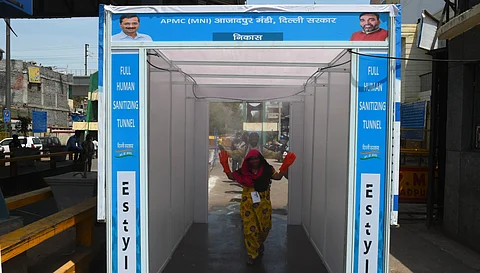

PALAKKAD/KOZHIKODE: Taking the battle against COVID-19 transmission to a new level, the local administration in a few districts, including Thrissur and Ernakulam, has introduced disinfection tunnels which spray hypochlorite fumes on people to sanitise them.
Even as the Walayar check-post became the latest to jump on the bandwagon, experts flayed the projected efficiency of these tunnels. R Sathyajith, the clinical Microbiologist and Infection Control Physician at the Avitis Institute of Medical Sciences in Nenmara, said global health agencies haven’t specifically recommended it for this purpose.
According to him, the major concern here is the impact chemicals like bleach (hypochlorite) or hydrogen peroxide solutions diluted with water may likely have on people over a period of time.
Dangerous proportions The real challenge now is to ensure that the chemicals used as disinfectants in tunnels are diluted to safe proportions.
Human error can lead to adverse health issues, including itching, irritation in eye and breathing difficulty.
He said even if hydrogen peroxide or bleach is used in very safe concentrations, ie 1/50 of the WHO-recommended safe dose for human contact, its efficacy and potency in killing the coronavirus will be called into question.
Proper disposal of wastewater is a challenge Since huge quantities of chemical-laden fumes are used, the possibility of wastewater draining from these tunnels is high. Unless the water is disposed of scientifically, it can lead to environmental pollution.
Experts say such tunnels may also give people a false sense of security and they may avoid practising social distancing etiquettes and washing hands etc.
Further, Sathyajith pointed out that the tunnels won’t benefit asymptomatic or symptomatic COVID-19 positive people and they will remain infectious even after passing through the tunnel.
‘Use resources for more effective equipment’ Since the mechanism is unscientific, the local administration in the respective regions should focus on engineering more effective approaches like building non-contact throat swab collection booths, intubation boxes and PPE which have clear scientific advantages.
Sathyajith said it is necessary to consider the environment, surfaces and objects as potentially contaminated till the virus is eradicated.
Patently absurd and utterly illogical: Ex-varsity prof Just as the local administration in various districts is pressing ahead with moves to set up disinfectant tunnels, some sections have flayed it for the complete lack of scientific basis. Spraying people with disinfectants with the aim of sanitising them is patently absurd, said an expert.
“There is a general myth that spraying disinfectants on people prevent the spread of the virus which is utterly illogical,” said Padmanaban Nair, former faculty member, department of chemistry, University of Calicut, and an expert in the field.
And toxic chemicals can cause an allergic reaction in those coming into direct contact with them.
According to Nair, the Centre for Disease Control and Prevention (CDC) in the US has specifically given detailed guidelines on the use of disinfectants.
Disinfection tunnels unscientific: CM
Sanitation and disinfection tunnels are unscientific according to experts, Chief Minister Pinarayi Vijayan said on Saturday. The state government will direct district collectors not to set up disinfection tunnels.
Such tunnels are unnecessary. Directives will be given to district collectors in this regard, he said.
General guidelines on use of disinfectants
The district Fire and Rescue officer, Palakkad, has come out with the following guidelines on use of disinfectants:
Universal Precautions with the appropriate personal protective equipment(PPE) should always be used.
The concentration, temperature, and exposure times are different for each disinfectant and the manufacturer’s directions for use must be strictly followed.
Chemical disinfectants should not be mixed with each other or with detergents, since this may affect disinfecting properties or create noxious fumes.
Precaution should be taken to avoid direct contact with chemical disinfectants.